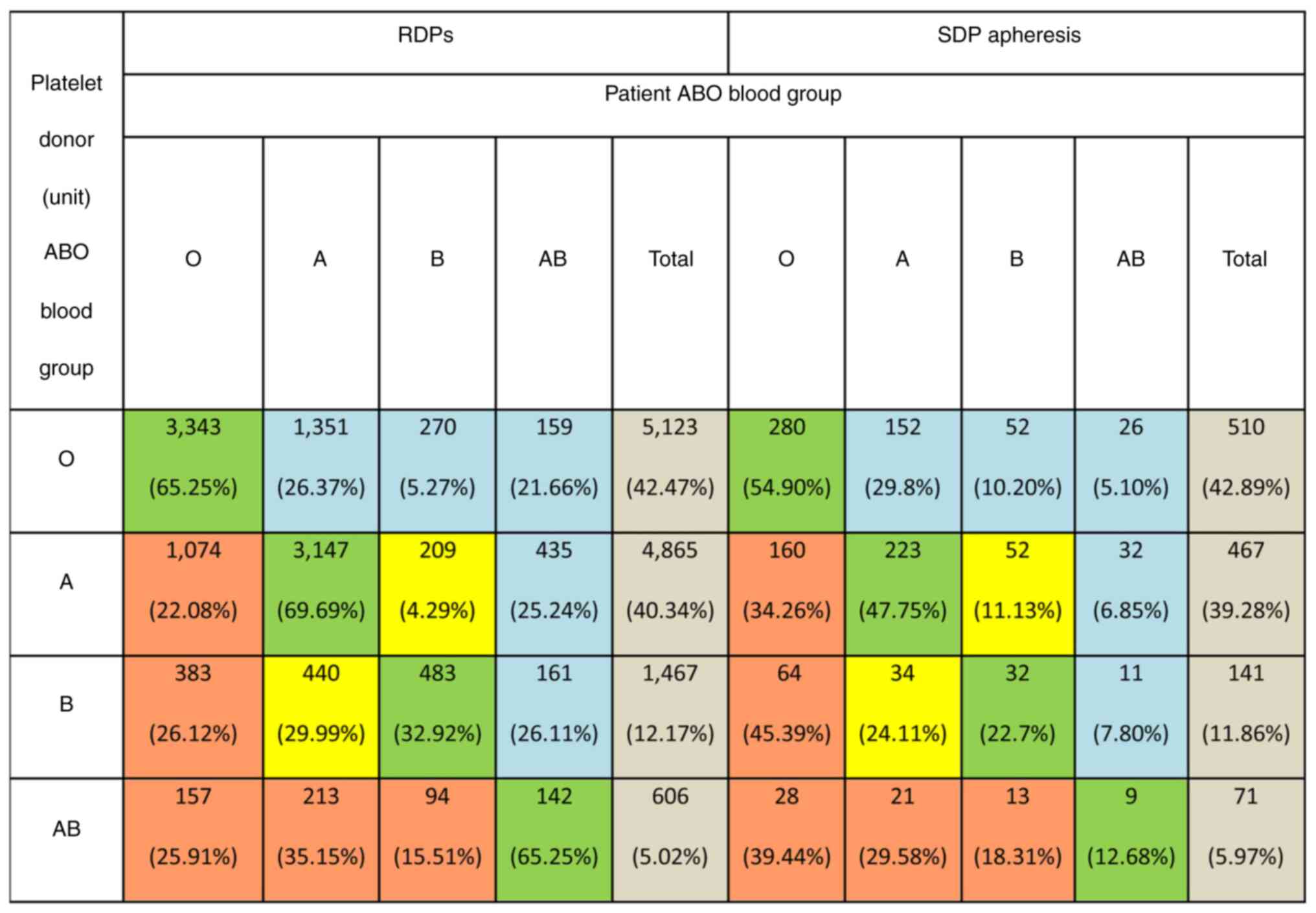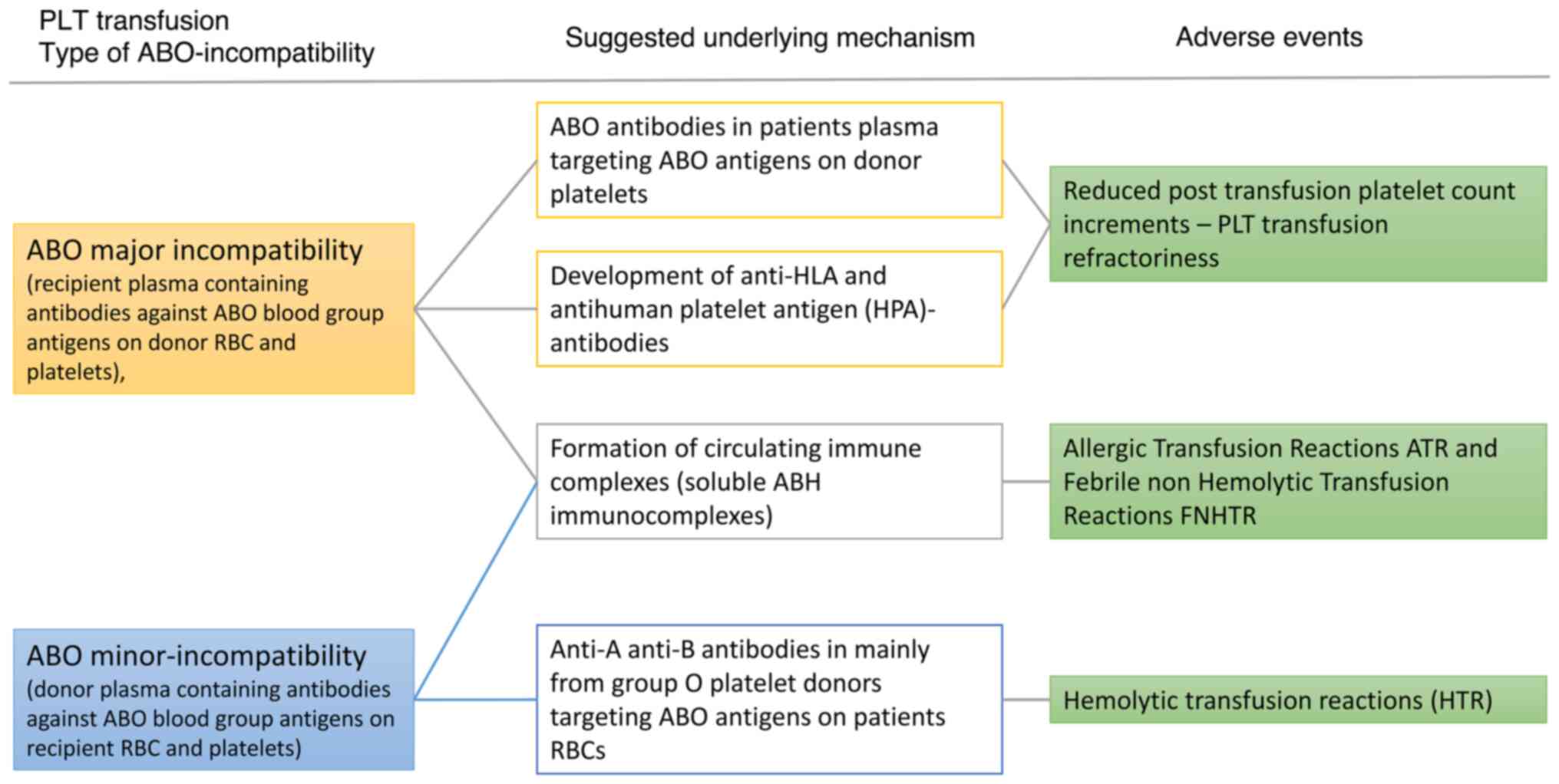|
1
|
Dunbar NM: Does ABO and RhD matching
matter for platelet transfusion? Hematology Am Soc Hematol Educ
Program. 2020:512–517. 2020.PubMed/NCBI View Article : Google Scholar
|
|
2
|
Kaufman RM, Djulbegovic B, Gernsheimer T,
Kleinman S, Tinmouth AT, Capocelli KE, Cipolle MD, Cohn CS, Fung
MK, Grossman BJ, et al: Platelet transfusion: A clinical practice
guideline from the AABB. Ann Intern Med. 162:205–213.
2015.PubMed/NCBI View
Article : Google Scholar
|
|
3
|
Kumar A, Mhaskar R, Grossman BJ, Kaufman
RM, Tobian AA, Kleinman S, Gernsheimer T, Tinmouth AT and
Djulbegovic B: AABB Platelet Transfusion Guidelines Panel. Platelet
transfusion: A systematic review of the clinical evidence.
Transfusion. 55:1116–1127, 1115. 2015.PubMed/NCBI View Article : Google Scholar
|
|
4
|
Lee EJ and Schiffer CA: ABO compatibility
can influence the results of platelet transfusion. Results of a
randomized trial. Transfusion. 29:384–389. 1989.PubMed/NCBI View Article : Google Scholar
|
|
5
|
Dunbar NM, Katus MC, Freeman CM and
Szczepiorkowski ZM: Easier said than done: ABO compatibility and D
matching in apheresis platelet transfusions. Transfusion.
55:1882–1888. 2015.PubMed/NCBI View Article : Google Scholar
|
|
6
|
Valsami S, Pouliakis A, Gavalaki M,
Argyrou A, Triantafillou E, Arvanitopoulou E, Girtovitis F,
Voulgaridou V, Megalou A, Chronopoulou P, et al: Platelets
transfusion in Greece: Where, when, why? A national survey. Asian J
Transfus Sci. 14:158–166. 2020.PubMed/NCBI View Article : Google Scholar
|
|
7
|
Adamidou D, Markantonatou A, Avramidou E,
Oikonomou M, Filippou A, Chroni A, Papadopoulou C, Abatzoglou E,
Sidi-Frankandrea V, Kourti M, et al: Efficacy of prophylactic
single donor platelets (SDP) transfusion is related to the time of
storage and not to the ABO compatibility in children with
malignancy. In: Proceedings of the 20th Congress of the European
Hematology Association. EHA, p407, Vienna, 2015.
|
|
8
|
Politis C, Richardson C, Asariotou M,
Grouzi EZ, E, Nomikou E, Katsarou O, Ganidou M, Martinis G,
Hatzitaki M and Halkia P: Transfusion adverse events (TAEs) and
errors/incorrect blood component transfused (IBCT) in Greece
2012-2017. Vox Sang. 114 (Suppl):S228–S229. 2019.
|
|
9
|
Quillen K: Hemolysis from platelet
transfusion: Call to action for an underreported reaction.
Transfusion. 52:2072–2074. 2012.PubMed/NCBI View Article : Google Scholar
|
|
10
|
Schiffer CA, Bohlke K, Delaney M, Hume H,
Magdalinski AJ, McCullough JJ, Omel JL, Rainey JM, Rebulla P,
Rowley SD, et al: Platelet transfusion for patients with cancer:
American society of clinical oncology clinical practice guideline
update. J Clin Oncol. 36:283–299. 2018.PubMed/NCBI View Article : Google Scholar
|
|
11
|
Valsami S, Dimitroulis D, Gialeraki A,
Chimonidou M and Politou M: Current trends in platelet transfusions
practice: The role of ABO-RhD and human leukocyte antigen
incompatibility. Asian J Transfus Sci. 9:117–123. 2015.PubMed/NCBI View Article : Google Scholar
|
|
12
|
Lialiaris T, Digkas E, Kareli D, Pouliliou
S, Asimakopoulos B, Pagonopoulou O and Simopoulou M: Distribution
of ABO and Rh blood groups in Greece: An update. Int J Immunogenet.
38:1–5. 2011.PubMed/NCBI View Article : Google Scholar
|
|
13
|
Asllani A, Culler E and Ettkin L: A
simulation-based apheresis platelet inventory management model.
Transfusion. 54:2730–2735. 2014.PubMed/NCBI View Article : Google Scholar
|
|
14
|
Gottschall J, Wu Y, Triulzi D, Kleinman S,
Strauss R, Zimrin AB, McClure C, Tan S, Bialkowski W, Murphy E, et
al: The epidemiology of platelet transfusions: An analysis of
platelet use at 12 US hospitals. Transfusion. 60:46–53.
2020.PubMed/NCBI View Article : Google Scholar
|
|
15
|
Curtis G, Scott M, Orengo L, Hendrickson
JE and Tormey CA: Very low rate of anti-D development in male,
primarily immunocompetent patients transfused with D-mismatched
platelets. Transfusion. 58:1568–1569. 2018.PubMed/NCBI View Article : Google Scholar
|
|
16
|
Gunson HH, Stratton F, Cooper DG and
Rawlinson VI: Primary immunization of Rh-negative volunteers. Br
Med J. 1:593–595. 1970.PubMed/NCBI View Article : Google Scholar
|
|
17
|
Cid J and Lozano M: Risk of Rh(D)
alloimmunization after transfusion of platelets from D+ donors to
D-recipients. Transfusion. 45:453–454. 2005.PubMed/NCBI View Article : Google Scholar
|
|
18
|
Reckhaus J, Jutzi M, Fontana S, Bacher VU,
Vogt M, Daslakis M and Mansouri Taleghani B: Platelet transfusion
induces alloimmunization to D and non-D rhesus antigens. Transfus
Med Hemother. 45:167–172. 2018.PubMed/NCBI View Article : Google Scholar
|
|
19
|
Baldwin ML, Ness PM, Scott D, Braine H and
Kickler TS: Alloimmunization to D antigen and HLA in D-negative
immunosuppressed oncology patients. Transfusion. 28:330–333.
1988.PubMed/NCBI View Article : Google Scholar
|
|
20
|
Goldfinger D and McGinniss MH:
Rh-incompatible platelet transfusions-risks and consequences of
sensitizing immunosuppressed patients. N Engl J Med. 284:942–944.
1971.PubMed/NCBI View Article : Google Scholar
|
|
21
|
McLeod BC, Piehl MR and Sassetti RJ:
Alloimmunization to RhD by platelet transfusions in autologous bone
marrow transplant recipients. Vox Sang. 59:185–189. 1990.PubMed/NCBI View Article : Google Scholar
|
|
22
|
Cid J, Lozano M, Ziman A, West KA, O'Brien
KL, Murphy MF, Wendel S, Vázquez A, Ortín X, Hervig TA, et al: Low
frequency of anti-D alloimmunization following D+ platelet
transfusion: the Anti-D alloimmunization after D-incompatible
platelet transfusions (ADAPT) study. Br J Haematol. 168:598–603.
2015.PubMed/NCBI View Article : Google Scholar
|
|
23
|
Ayache S and Herman JH: Prevention of D
sensitization after mismatched transfusion of blood components:
Toward optimal use of RhIG. Transfusion. 48:1990–1999.
2008.PubMed/NCBI View Article : Google Scholar
|
|
24
|
Poston JN, Sugalski J, Gernsheimer TB,
Marc Stewart F and Pagano MB: Mitigation strategies for anti-D
alloimmunization by platelet transfusion in haematopoietic stem
cell transplant patients: A survey of NCCN® centres. Vox
Sang. 115:334–338. 2020.PubMed/NCBI View Article : Google Scholar
|
|
25
|
Solves Alcaina P: Platelet transfusion:
And update on challenges and outcomes. J Blood Med. 11:19–26.
2020.PubMed/NCBI View Article : Google Scholar
|
















